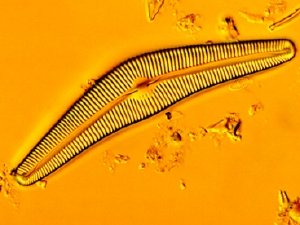Oct 22 2010
Nature has one very big advantage over any human research team: plenty of time. Billions of years, in fact. And over all that time, it has produced some truly amazing materials — using weak building blocks that human engineers have not yet figured out how to use for high-tech applications, and with many properties that humans have yet to find ways to duplicate.
But now a number of researchers such as MIT professor Markus Buehler have begun to unravel these processes at a deep level, not just finding out how the materials behave but what the essential structural and chemical characteristics are that give them their unique properties. In the future, they hope to mimic those structures in ways that produce even better results.
 An image of a species of diatom, Cymbela cistula. Marcus Buehler says diatoms are a good example of the way weak building blocks — in this case, fragile and brittle silica — can be used in biology to build strong and durable materials, by assembling them in structures organized differently at different scales.
Image: NSF
An image of a species of diatom, Cymbela cistula. Marcus Buehler says diatoms are a good example of the way weak building blocks — in this case, fragile and brittle silica — can be used in biology to build strong and durable materials, by assembling them in structures organized differently at different scales.
Image: NSF
It all comes down to assembling complex structures from small, simple building blocks, Buehler explains. He likes to use a musical analogy: A symphony comprises many different instruments, each of which on its own could never produce something as grand and complex as the combined rich, full musical experience. In a similar way, he hopes to construct complex materials with previously unavailable properties by using simple building blocks assembled in ways that borrow from those used by nature.
Human engineers, he explains, do have at least one important advantage over nature: They can choose their materials. Nature, by contrast, often has to make do with whatever is readily available locally, and whatever structures have been created through the lengthy trial-and-error of evolution. “A spider or a cell,” Buehler says, “doesn’t have great resources. It can’t import materials, it uses what’s available.”
In biological materials such as spider silk, the geometry of the structures makes all the difference. Silk, a subject of earlier studies by Buehler and his colleagues, is made up of molecules that are, in themselves, inherently weak, but the basic disk-shaped molecules are combined into small stacks, which are in turn combined into cross-linked fibers in a way that makes the whole far stronger than its component parts. Engineers could learn a thing or two from such structures, Buehler suggests, with their different arrangements at different scales. “If we figure out how to design things at multiple scales, we don’t need fancy building blocks,” he says.
Peter Fratzl, a materials scientist at the Max Planck Institute of Colloids and Interfaces in Germany, sees great promise in this approach. “It is not so much the chemical composition that really counts, but the way the components (which may be intrinsically poor) are joined together,” he says. “Unraveling these structural principles requires experimental as well as theoretical approaches covering many length scales, from the size of molecules to complete organs.” So far, the research has been mostly on the theoretical side, but Buehler and others are hoping to proceed with experimental work as well.
This design approach not only holds the promise of creating materials with great qualities of strength, or stretchiness, or with useful optical or electrical properties, but also for making use of materials that are now thought to be of little use, or even waste products.
Hierarchical structures
The key to making strong materials out of weak components, Buehler has found, lies in the way small pieces are arranged into larger patterns in different ways at different scales — in other words, in a hierarchical set of structures. “This paradigm, the formation of distinct structure at multiple length scales, enables biological materials to overcome the intrinsic weaknesses of the building blocks,” he wrote in a paper appearing this month in the journal Nano Today.
Most of the structural materials designed by people, on the other hand — steel, bricks, mortar — have simple structures that do not vary with scale, although some composite materials and structures built from components such as carbon nanotubes are beginning to implement at least some differentiation of structure with scale. But Buehler sees this as an area that is ripe for much more sophisticated and complex new designs.
Buehler suggests that just as biology has done, humans could engineer materials with desired properties such as strength or flexibility by using abundant and cheap materials such as silica, which in bulk form is brittle and weak. “The design of hierarchical structures could be the key to overcome their intrinsic weakness or brittleness, properties that currently prevent their widespread technological application,” he wrote in the Nano Today paper. Using cleverly designed structures, he suggests, humans should be able to produce materials with almost any kind of desired properties, even using a very limited, and “almost arbitrary” set of components.
“We’re trying to develop computer models,” he says, “so that we can make predictions” about the properties of materials built in ways that have never been made before. “As engineers, we have models for how to make a car, or a building,” he says. But for designing the basic structures of new materials, the technology today “is really at an infant stage.” But as such models are developed, he says confidently, “we can do much better than biology.”